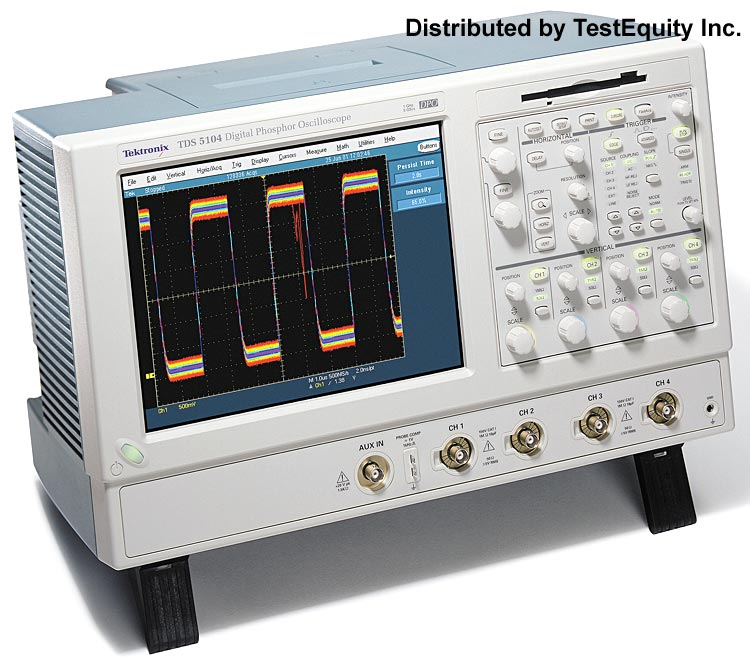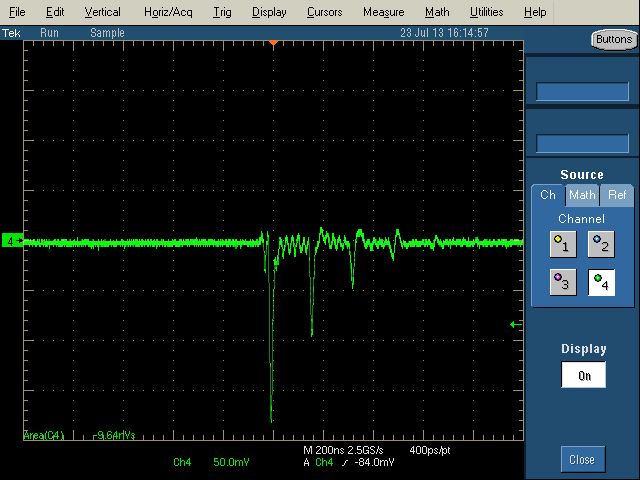MainPage:Nuclear:Summer2013:FastAmplifier
| ⇐ Back to Summer 2013 |
| ⇐ Back to the Main_Page |
Goal
Determine appropriate amplifier for a photomultiplier tube to be used in a detector, so as to prevent the background noise from drowning out the signal from the photomultiplier tube.
Challenges
Slew Rate
The slew rate is defined as the measurement of how fast an amplifier can respond to an electrical signal. Thus, the slew rate determines the range of frequencies that can be amplified according to the formula S = 2πfV where f is frequency and V is peak voltage. The slew rate must be greater than or equal to 2πfV, in order to amplify a periodic sinusoidal signal at a frequency f. In order for our amplifier to work with the photomultiplier tube, the slew rate must be high enough to accurately amplify the signal. The slew rate is expressed in volts per second, but more commonly volts per microsecond. The two amplifiers we considered are the LM 741C Operational Amplifier and the 595-THS3202D high speed operational amplifier.
Cost
While not necessarily a major concern, it would be in the best interest of the program to find an optimal solution that gives good results with as little cost as possible. It would be preferable to use cheaper amplifiers due to the fact that amplifiers may break down, so a cheaper amplifier would also provide many replacements.
Software & Hardware Issues
There was an issue with the computer that has been set aside for recording data. It was displaying a message of kernel panic - not syncing. In order to continue our research with photomultipliers, we must fix this issue in order to record our data. This is the output of the error screen.
export: 63: PATH=/sbin:/bin:/usr/sbin:/usr/bin: bad variable name Kernel panic - not syncing: Attempted to kill init! Pid: 1, comm: init Not tainted 2.6.32-358.e16.i686 #1 Call Trace: [<c084771f>] ? panic+0x6e/0x122 [<c045cff1>] ? do_exit+0x741/0x750 [<c045d03c>] ? do_group_exit+0x3c/0xa0 [<c045d0b1>] ? sys_exit_group+0x11/0x20 [<c084a2f4>] ? syscall_call+0x7/0x6
UPDATE (July 11th, 2013):
We have successfully fixed the software issues. Running a memory diagnostics tool, we found that the RAM used by the computer was corrupted. By switching out the bad RAM with working RAM from another computer of the same model, we were able to fix the issue. The computer now boots up normally and can be used again. For future reference, this machine should be connected to an Uninterrupted Power Supply (UPS) to avoid damages from power surges and to keep data backed up in case of power failure. In addition this machine should be shutdown and completely turned OFF when not in use to avoid future problems.
Amplifiers
There are two different amplifiers we considered for usage in the detector. The LM 741C operational amplifier and the 595-THS3202D high speed operational amplifier. Preliminary research indicates that the LM 741C op amp is unsuitable for our purposes. The slew rate is not high enough and the amplification bandwidth is not wide enough. An important aspect of amplification is to realize that when the gain is increased, the bandwidth is decreased. This phenomenon can be credited to the slew rate. When a signal is amplified, it attains a certain voltage. When the gain is increased, the voltage gets higher. The response time of the amplifier is dependent on its slew rate.
For example, the slew rate of Amplifier X is 100 V/μs. Let us amplify a signal of 1 volt by this amplifier. We will set the gain to one so that we deal with the simplest case first. If my outgoing signal is 1 volt, how fast is the response time of the amplifier? This is how to do the calculation,
(Amplified Voltage)/(Slew Rate)
=(1 volt)/(100 volts/microsecond)
=0.01 microsecond
=10 nanoseconds
This calculation is useful for estimating the response time for a pulse being amplified. This formula does not apply to periodic signals.
741C Operational Amplifier
Benefits
The 741C operational amplifier is fairly cheap (approximately $0.75 per chip) and quite durable. It has an operating temperature range of 0 to 70 Celsius. It is a popular component for many electronic applications. An operational amplifier can be configured in many ways to sum, subtract, integrate or differentiate signals. However, for our purposes, we need only a non-inverting amplifier.
Drawbacks
Low slew rate and the amplification bandwidth only extends to about 1 MHz. For our purposes, we need an amplification bandwidth of 1 GHz or more is required to amplify the signals coming from the photomultiplier tube. A test was performed using the 741C Operational Amplifier. The amplification unity-gain bandwidth only extended to 1.2 MHz, which is much too slow for use in amplifying the pulses from a photomultiplier.
Data sheet for the LM741C can be found here.
595-THS3202D high speed operational amplifier
Benefits
The slew rate for the 595-THS3202D high speed operational amplifier is very high and has an unity-gain amplification bandwidth of 2 GHz. This means that the amplifier can properly amplify signals of up to 2 GHz without any major signal distortions. The photomultiplier tubes produce pulses in the nanosecond range, thus a bandwidth in the gigahertz range is necessary. The slew rate that is listed in the data sheet is 900 V/μs.
Drawbacks
The 595-THS3202D high speed operational amplifier is quite expensive and very fragile. It is approximately $10 per chip. Electrostatic charge collected on the body can be enough to blow out the solid state electronics packed within the chip. This chip is quite fragile and quite small, extreme care must be taken in order to ensure that the chip remains working.
Data sheet for the 595-THS3202D can be found here.
Equipment
Currently the oscilloscope we are using for data collection from the photomultipliers is the Tektronix TDS 5104 4 Channel Digital phosphor oscilloscope. It has a 1 GHz bandwidth and 5 GS/s sample rate. A bandwidth lower than 1 GHz is unacceptable for measuring fast pulses. The pulses that are measured might only last a few nanoseconds. Thus, this oscilloscope is adequate for the experimental needs. Our group is utilizing a LeCroy 22419A ADC as our analog to digital signal converter. Our pulse counter is an Ortec 994 Dual Counter/Timer.
The oscilloscope has a recording length of 8 MB.
Photomultiplier Tubes (PMT)
Basic Operation Principle
A photomultiplier tube (PMT) is a device that has the capability of detecting single photons and small pulses of light. The underlying principle governing the workings of the device is the photoelectric effect. The photoelectric effect is simply the action of a photon (with sufficient energy) knocking an electron out of orbit. This electron is then multiplied by a series of plates called dynodes. The dynodes are at a positive voltage so that the electron is accelerated towards the plate. When the electron collides with the dynode a shower of electrons are emitted. These electrons then are accelerated towards the other dynodes and it also emits a shower of electrons. This avalanche effect results in thousands and sometimes millions of electrons being liberated. These are the electrons that are detected as an electrical pulse.
The photo above is a diagram of a head on type PMT. This is one of the most common types of PMT's, and we will be using this type of PMT for all of our work. There are other types of PMT's such as the Microchannel Plate PMT's (highly compact and efficient).
PMT Gain
The gain of a PMT is directly proportional to the voltage applied to the dynodes and the number of dynodes. The gain of a PMT usually ranges from one million to one hundred million. This large gain is sometimes large enough to be detected directly, however tests will have to be run in order to test if this claim is true. If the gain is sufficiently large, then no amplifier is required. If it is not, an amplifier will be required.
Type of PMT
Currently we are testing the Hamamatsu R4125HA photomultiplier tube. The PMT gain was listed as 8.7 x 10^5. It has a maximum operating voltage of 1500 volts. However internet research indicates that operating the tube at 200 to 300 volts lower than the maximum rating is optimal. Some preliminary tests have already been run. We operated the tube at 1100 volts and placed the tube in a dark box. The dark box had a small opening and an LED was placed at the end of the darkened window. The red LED was given 10 millisecond pulses at 2.35 volts. We noticed a signal of 10 mV with a background noise of 3-5 mV.
PMT Noise
Thermoluminescence
The PMT's emit noise in a variety of ways. Dark current is one such mode of noise transmission. Dark current occurs when the window surface of the PMT emits photons from energy stored in a process known as thermoluminescence. When certain crystalline structures have stored electromagnetic radiation (or other forms of energy), the energy can be re-emitted as electromagnetic radiation upon heating, this is known as thermoluminescence. This is why the PMT's must always be capped when not in use. This is so the dark current is reduced, thus reducing noise.
Thermal Noise
In many applications, the PMT's are kept at cold temperatures to reduce thermal noise. Electrons from a metal can be released while heating the substance.
General Electronics Issues
Reflected Pulses
When two devices are connected by a wire to each other, a phenomenon known as a "reflected pulse" can occur. This occurs when the internal impedance of the two devices are not equal. This can cause false pulses to appear. Suppose the a PMT counts one photon, you should get one pulse. However the mismatch of impedance can cause extra pulses to be added. Pulses that do not exist. An ADC will not be able to distinguish a true pulse from a reflected pulse, this is why impedance matching is very important. The following scope trace is an example of a reflected pulse. The Hamamatsu R4125HA PMT was excited with 15 nanosecond LED pulses in a dark box. A 70.5 nanosecond cable was connected from the PMT signal output to the oscilloscope. As you can notice an extra pulse approximately every 140 nanoseconds was observed, and the pulses decayed linearly. This provides strong evidence that we are observing reflected pulses.
Procedure
We will begin by testing the PMT without an amplifier to see if we can get a discernible signal consistently, which could potentially allow us to skip using an amplifier altogether. If this course of action does not pan out, we will move on to testing the PMT with both amplifiers and comparing the data. This should help us see which amplifier is the right fit for this usage.
Hopefully we will start our experiment on July 23. We will be measuring the signal from the PMT under three conditions:
- Unamplified
- Amplified with the 741C
- Amplified with the 595-THS3202D.
In particular, we will be looking for any substantial change in the accuracy of the readout and drop in background noise. We expect the 741C to show the most inaccuracy on readout due to it's substantially lower slew rate compared to the 595-THS3202D, and the 595-THS3202D to offer the most acurate and readable results.


